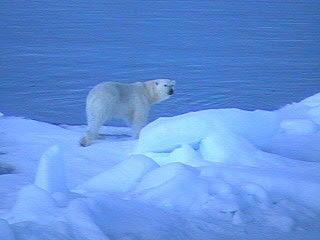
|
|
7 July, 2001
Back Into the Open Water - and Bears
Saturday, 7 July 2001
God afton! (Good afternoon!)
Life on Board
Polar bears are amazing. Here is a large mammal that can actually survive
in this extreme climate, regularly diving in and out of the Arctic water,
requiring great amounts of nutrients to produce the blubber that keeps it
alive. Their main food is seals (not sea lions, which don't live this far
north) but they will eat anything to survive including beluga whales,
narwhals, muskoxen, walrus, hares, lemmings, birds and eggs, berries,
seaweed, or the occasional science teacher. Anything already dead is also
acceptable food (Barry Lopez, Arctic Dreams).
About midnight, we were heading out of the ice to the east for a 30-hour
station in the open water since we had been unable to take any data earlier
due to the storm. Most people were still awake because, having just left a
station, there was much to be done to wrap up the work. One of the crewmen
came by and shouted, "Ice bear, starboard side!" We were moving through
mostly open water already with intermittent, large floating ice floes.
Everyone dropped what they were doing to grab cameras and binoculars. I
raced up to the 4th deck to grab my camera and ran outside. There he was,
swimming strongly along through the water, glancing back at this huge ship
keeping pace alongside (the 2nd Officer was steering at the time and
obliged us by slowing down to swimming-bear speed). The white bear didn't
seem that bothered, just a little annoyed that we may have interrupted his
hunting. He made for an ice floe and hauled out, pausing to shake off
water like a dog, then trotted to the far side. He posed for photos for a
few moments, testing the wind, then he decided he would continue on and
slipped back into the water. We left him then, happy to be given the
opportunity to be noticed by such an animal.
Scientists at Work
We arrived at the Open Water (OW) station at approximately 6 am and the
sampling rosette was lowered for water samples. The scientists actually
refer to this as a CTD cast because, in addition to taking water samples,
instruments on the rosette measure Conductivity, Temperature, and Density
as it is lowered through the water. From these data, the salinity (salt
content) of the water can be calculated and all of these parameters will be
used to examine the relationships between these physical attributes of the
water column and the flora and fauna collected in the seawater samples at
each depth.
One of the subgroups in the atmospheric chemistry group is the
meteorological group. They have installed instruments on the helicopter
which can measure pressure, temperature, humidity, and an important
chemical called dimethylsulfide, or DMS. This is a compound produced by
marine algae after they die and start to decay. It gets into the
atmosphere where it undergoes some chemical processes and turns into sulfur
dioxide (SO2), sulfuric acid (H2SO4), and other acids. The helicopter
gathers data as it flies around and the scientists can combine this
information with the weather balloon and ship data. The helicopter has
been doing 2 flights each day if the weather permits.
Where Are We Now?
This Open Water station position is 78o39' N latitude and 33o01' E
longitude. I awoke to a bright, sunny day, completely flat ocean as far as
you could see in every direction. All of the Europeans were sitting in the
sun on every deck whenever and wherever they could until about 3 pm when
the clouds came in.
E-MAIL! I finally can read most of my email but I can't reply to each
personally due to the extremely expensive satellite time although I will
reply to some using this section of my daily journal. Thanks again to
everyone for the good wishes.
Martin Jeffries: Hello to Fairbanks, Alaska. Thanks for the
encouragement. Jim, Debby, & Emma Kleck: Love and best wishes sent to
Santa Cruz, California and thanks for checking up on me. Michelle Adams,
future Teacher in the Arctic: email is a serious problem, especially above
80o North latitude due to the curvature of the earth. Until recently, the
only satellite available for communication was the Imarsat. Very new is
the Iridium Satellite System, first open for data communication at the end
of June this summer. Their voice communication has been available for some
time but Internet connection is brand new. The connection is somewhat
difficult to maintain and it may take 3-4 minutes to send one email and it
has taken me 7-10 minutes to send a picture (all chargeable minutes, of
course). Hence, my decision to answer some emails here in my daily
journal. You need to have an Iridium phone with special datakit modem for
Internet. I don't know how the USCGC Healy is set up but perhaps you will
have an easier time.
Vi ses! (See you later!)
From Deck 4 on the Icebreaker Oden, somewhere in the Barents Sea,
Dena Rosenberger

Contact the TEA in the field at
.
If you cannot connect through your browser, copy the
TEA's e-mail address in the "To:" line of
your favorite e-mail package.
|
